 | | | Switch to: Europe, USA, New Zealand, Antarctica Credit: NOAA/Ovation  Planetary K-index Planetary K-index
Now: Kp= 2 quiet
24-hr max: Kp= 3 quiet
explanation | more data
Interplanetary Mag. Field
Btotal: 6.31 nT
Bz: 0.53 nT north
more data: ACE, DSCOVR
Updated: Today at 1146 UT  Coronal Holes: 22 Aug 22 Coronal Holes: 22 Aug 22 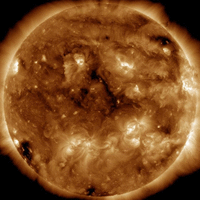
There are no significant coronal holes on the Earthside of the sun. Credit: SDO/AIA  Noctilucent Clouds Noctilucent Clouds
Noctilucent cloud season is underway--but also nearing its end. AIM images show the polar ring of NLCs is contracting as northern summer winds down. Switch view: Europe, USA, Asia, Polar Updated Aug22  SPACE WEATHER
NOAA Forecasts | | Updated at: 2022 Aug 22 2245 UTC FLARE | 0-24 hr | 24-48 hr | CLASS M | 05 % | 05 % | CLASS X | 01 % | 01 % |  Geomagnetic Storms: Geomagnetic Storms:
Probabilities for significant disturbances in Earth's magnetic field are given for three activity levels: active, minor storm, severe storm Updated at: 2022 Aug 22 2245 UTC Mid-latitudes | 0-24 hr | 24-48 hr | ACTIVE | 25 % | 25 % | MINOR | 10 % | 10 % | SEVERE | 01 % | 01 % | High latitudes | 0-24 hr | 24-48 hr | ACTIVE | 15 % | 15 % | MINOR | 30 % | 30 % | SEVERE | 30 % | 30 % | | | |  | | | | | | | | | | | Never miss another geomagnetic storm. Sign up for Space Weather Alerts and you'll receive a text message when magnetic storms erupt. Aurora tour guides and professional astronomers use this service. You can, too! | | | THE STORMS ARE OVER: NOAA forecasters say that G1-class geomagnetic storms are possible on Aug. 22nd. More likely, the storms are over. A final minor CME launched toward Earth by old sunspot AR3078 might indeed graze our planet's magnetic field today. However, it is already late, and thus slow; a tardy impact is unlikely to produce geomagnetic storms. Aurora alerts: SMS Text AURORAS IN THE USA: Last week at least three CMEs hit Earth, none with great force, but together they were sufficient to spark multiple geomagnetic storms. On Aug. 20th, auroras spilled over the Canadian border into Ely, Minnesota: 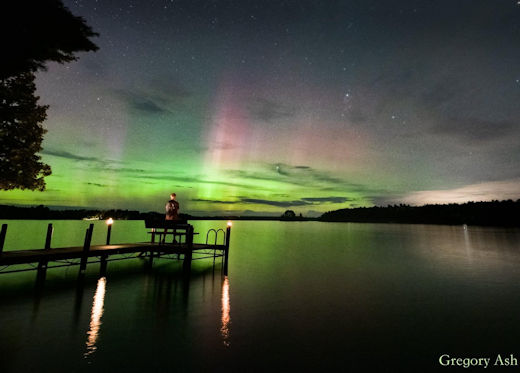
"After the cloud deck broke, I was able to watch these beautiful pink pillars roll across the sky," says photographer Greg Ash, located at the end of the dock. "They were very visible to the naked eye." Note: The storms were originally predicted to reach category G3 (strong). Instead they peaked at category G2 (moderate), one notch below. That doesn't mean the forecast was wrong; if only one of the CMEs had been a little more potent, the needle almost certainly would have hit the predicted value. Solar Cycle 25 is just getting started, so there will be a next time. Stay tuned! Aurora alerts: SMS Text more images: from Marybeth Kiczenski of Mackinaw City, Michigan; from Elon Gane of Mohall, North Dakota; from Ethan Hohnke of Charlevoix, Michigan; from Sam Warfel of Whitefish Point, Michigan; Realtime Aurora Photo Gallery
Free: Spaceweather.com Newsletter DANCING SPRITES OVER PUERTO RICO: Pro tip for storm chasers: Point your cameras just above the thundercloud. You might see something like this: 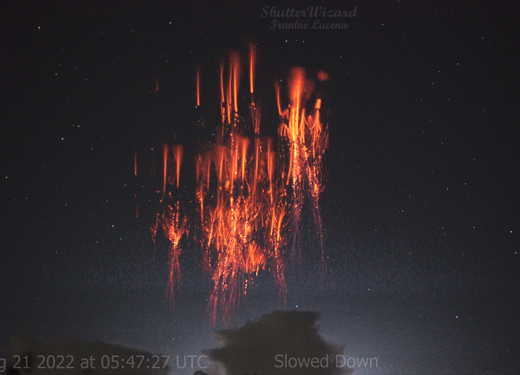
Frankie Lucena photographed the display last night from Cabo Rojo, Puerto Rico. He caught at least half a dozen red sprites leaping up from a powerful thunderstorm offshore: map. "These are dancing sprites," says Lucena. "That's when a sprite event contains multiple sprites that fire up in a sequence. I combined them by stacking 10 video frames to show how impressive this event really was." A slow motion video shows the individual dancers. Realtime Sprite Photo Gallery
Free: Spaceweather.com Newsletter "I LOVE YOU MORE" OPAL: Nothing says "I love you" like jewelry from space. On June 3, 2022, this sterling silver opal pendant hitched a ride on an Earth to Sky Calculus cosmic ray research balloon. At the apex of the flight it floated 101,326 feet above the Sierra Nevada mountains of central California:
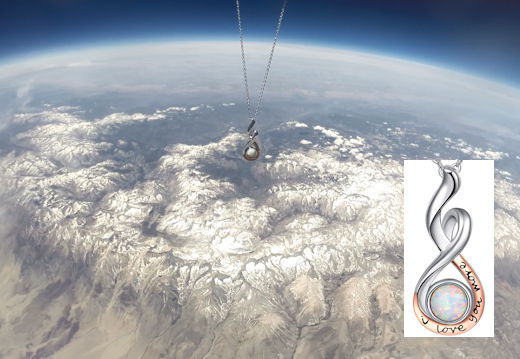
You can have it for $142.95. The opal's infinity wrap is engraved with "I Love You More." It's the perfect birthday, anniversary or (never too early!) Christmas gift for that special someone who loves space. Each pendant comes with a greeting card showing the pendant in flight and telling the story of its trip to the stratosphere and back. Far Out Gifts: Earth to Sky Store
All sales support hands-on STEM education
Realtime Noctilucent Cloud Photo Gallery
Free: Spaceweather.com Newsletter
Realtime Space Weather Photo Gallery
Free: Spaceweather.com Newsletter Every night, a network of NASA all-sky cameras scans the skies above the United States for meteoritic fireballs. Automated software maintained by NASA's Meteoroid Environment Office calculates their orbits, velocity, penetration depth in Earth's atmosphere and many other characteristics. Daily results are presented here on Spaceweather.com. On Aug 24, 2022, the network reported 4 fireballs.
(4 sporadics) 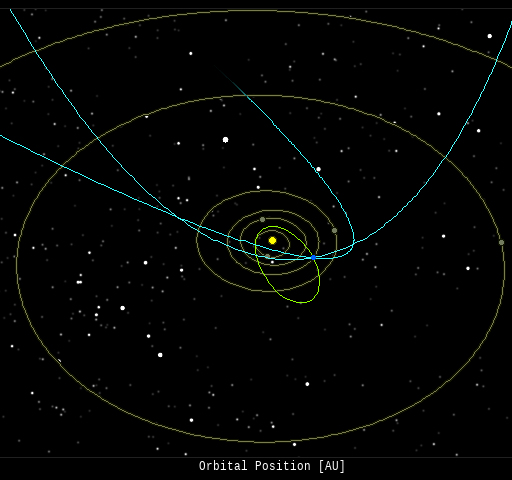 In this diagram of the inner solar system, all of the fireball orbits intersect at a single point--Earth. The orbits are color-coded by velocity, from slow (red) to fast (blue). [Larger image] [movies] Potentially Hazardous Asteroids ( PHAs) are space rocks larger than approximately 100m that can come closer to Earth than 0.05 AU. None of the known PHAs is on a collision course with our planet, although astronomers are finding new ones all the time. On August 22, 2022 there were 2288 potentially hazardous asteroids.
 | Recent & Upcoming Earth-asteroid encounters: | Asteroid | Date(UT) | Miss Distance | Velocity (km/s) | Diameter (m) | | 2022 QF | 2022-Aug-17 | 3.9 LD | 20.1 | 65 | | 2022 QB | 2022-Aug-17 | 4 LD | 6.9 | 11 | | 2022 PC | 2022-Aug-18 | 16.4 LD | 4.1 | 63 | | 2022 QC1 | 2022-Aug-18 | 7.2 LD | 15.6 | 31 | | 2022 QH2 | 2022-Aug-19 | 3.5 LD | 16.4 | 30 | | 2022 QC | 2022-Aug-20 | 2.6 LD | 17.5 | 31 | | 2022 QA1 | 2022-Aug-20 | 11 LD | 8.3 | 32 | | 2022 QW1 | 2022-Aug-20 | 0.5 LD | 10.9 | 13 | | 2022 QE1 | 2022-Aug-20 | 0.5 LD | 6.3 | 8 | | 2019 AV13 | 2022-Aug-20 | 13.8 LD | 9.2 | 135 | | 2022 QB1 | 2022-Aug-20 | 5.5 LD | 3.7 | 6 | | 2020 QW3 | 2022-Aug-22 | 14.1 LD | 18.1 | 30 | | 2022 QM | 2022-Aug-22 | 18.8 LD | 5.1 | 20 | | 2022 QV | 2022-Aug-22 | 2.2 LD | 21.9 | 23 | | 2015 QH3 | 2022-Aug-22 | 5.6 LD | 7 | 14 | | 2022 QX | 2022-Aug-23 | 7.3 LD | 12.7 | 18 | | 2022 QR | 2022-Aug-24 | 3.6 LD | 8.6 | 14 | | 2017 BU | 2022-Aug-29 | 15.8 LD | 7 | 32 | | 2022 QX1 | 2022-Aug-31 | 5.4 LD | 21.2 | 46 | | 2021 CQ5 | 2022-Sep-01 | 8.7 LD | 13.5 | 7 | | 2022 QB2 | 2022-Sep-01 | 10.3 LD | 15.9 | 30 | | 2022 QF2 | 2022-Sep-11 | 19.1 LD | 8.4 | 46 | | 2008 RW | 2022-Sep-12 | 17.5 LD | 10.2 | 98 | | 2020 PT4 | 2022-Sep-15 | 19.7 LD | 10.8 | 39 | | 2022 QD1 | 2022-Sep-16 | 19.5 LD | 9.5 | 71 | | 2016 HF2 | 2022-Sep-29 | 19.2 LD | 5.6 | 21 | | 2018 ER1 | 2022-Oct-02 | 14.7 LD | 4 | 27 | | 2018 VG | 2022-Oct-05 | 18.5 LD | 6.7 | 12 | | 2021 TJ10 | 2022-Oct-06 | 19.6 LD | 8.1 | 6 | | 2006 SG7 | 2022-Oct-07 | 16.7 LD | 18.4 | 93 | | 2013 TJ6 | 2022-Oct-07 | 11.7 LD | 14.4 | 32 | | 2013 SL20 | 2022-Oct-14 | 6.2 LD | 12.1 | 45 | | 2020 TO2 | 2022-Oct-15 | 1.4 LD | 12.6 | 18 | | 2020 BD | 2022-Oct-16 | 12.1 LD | 11.4 | 20 | Notes: LD means "Lunar Distance." 1 LD = 384,401 km, the distance between Earth and the Moon. 1 LD also equals 0.00256 AU. | | Cosmic Rays in the Atmosphere | SPACE WEATHER BALLOON DATA: Almost once a week, Spaceweather.com and the students of Earth to Sky Calculus fly space weather balloons to the stratosphere over California. These balloons are equipped with sensors that detect secondary cosmic rays, a form of radiation from space that can penetrate all the way down to Earth's surface. Our monitoring program has been underway without interruption for 7 years, resulting in a unique dataset of in situ atmospheric measurements. Latest results (July 2022): Atmospheric radiation is decreasing in 2022. Our latest measurements in July 2022 registered a 6-year low: 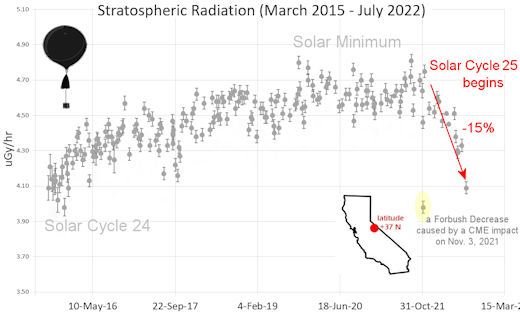
What's going on? Ironically, the radiation drop is caused by increasing solar activity. Solar Cycle 25 has roared to life faster than forecasters expected. The sun's strengthening and increasingly tangled magnetic field repels cosmic rays from deep space. In addition, solar coronal mass ejections (CMEs) sweep aside cosmic rays, causing sharp reductions called "Forbush Decreases." The two effects blend together to bring daily radiation levels down. .Who cares? Cosmic rays are a surprisingly "down to Earth" form of space weather. They can alter the chemistry of the atmosphere, trigger lightning, and penetrate commercial airplanes. According to a study from the Harvard T.H. Chan school of public health, crews of aircraft have higher rates of cancer than the general population. The researchers listed cosmic rays, irregular sleep habits, and chemical contaminants as leading risk factors. A number of controversial studies (#1, #2, #3, #4) go even further, linking cosmic rays with cardiac arrhythmias and sudden cardiac death. Technical notes: The radiation sensors onboard our helium balloons detect X-rays and gamma-rays in the energy range 10 keV to 20 MeV. These energies span the range of medical X-ray machines and airport security scanners. Data points in the graph labeled "Stratospheric Radiation" correspond to the peak of the Regener-Pfotzer maximum, which lies about 67,000 feet above central California. When cosmic rays crash into Earth's atmosphere, they produce a spray of secondary particles that is most intense at the entrance to the stratosphere. Physicists Eric Regener and Georg Pfotzer discovered the maximum using balloons in the 1930s and it is what we are measuring today. | | The official U.S. government space weather bureau | | | The first place to look for information about sundogs, pillars, rainbows and related phenomena. | | | Researchers call it a "Hubble for the sun." SDO is the most advanced solar observatory ever. | | | 3D views of the sun from NASA's Solar and Terrestrial Relations Observatory | | | Realtime and archival images of the Sun from SOHO. | | | information about sunspots based on the latest NOAA/USAF Active Region Summary | | | current counts of failed and deployed Starlink satellites from Jonathan's Space Page | | | Authoritative predictions of space junk and satellite re-entries | | | from the NOAA Space Environment Center | | | fun to read, but should be taken with a grain of salt! Forecasts looking ahead more than a few days are often wrong. | | | from the NOAA Space Environment Center | | | the underlying science of space weather |  | BestCSGOGambling is the best site for everything related to CSGO gambling on the web |  | To find reviews of new online casino sites in the UK try The Casino DB where there are hundreds of online casino reviews complete with bonuses and ratings. Alternatively, Online-Casinos.xyz is another massive directory of online casinos listing sites for the UK and Worldwide. Casinos that offer Rupees for bonuses are very generous to Indian players. Find the best online casinos in India at AllCasinos.in Looking for a new online casino? Try Casimpo the new site dedicated to making online casino simple, or check out the new Avenger Slots Casino and Ace Online Casino with over 500 online slots and casino games. |  | One of the most popular casino games is the Book Of Dead Slot based on ancient Egyptian text, you can find all the casinos with spins at bookofdeadslotsites.com. |  | When looking for casinos to play online when the weather is bad, you can try casino online trucchi for Italian games. If you are not from Finland you can try the Swedish page Svenska casino online to find suitable games, check out svenskacasinoonline.net. Always check your local laws before playing with real money. |  | Looking for sports betting companies not registered on GamStop? CasinoGap has presented a list of sites not on GamStop available for UK players. Check and bet online! Would you like to bet at sites not using GamStop? Look at a list of NonStopCasino sites for online betting that aren't on GamStop. Top-rated bookmakers ever! | | | These links help Spaceweather.com stay online. Thank you to our supporters! | | | | | | | | |  | |  |   | ©2021 Spaceweather.com. All rights reserved. This site is penned daily by Dr. Tony Phillips. | |

